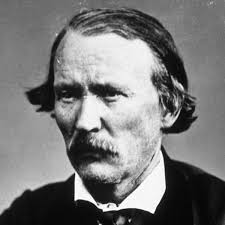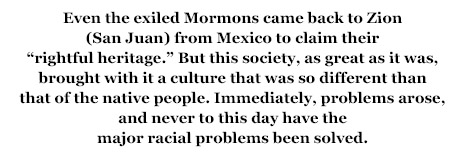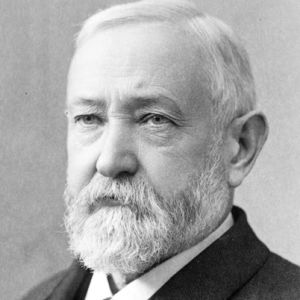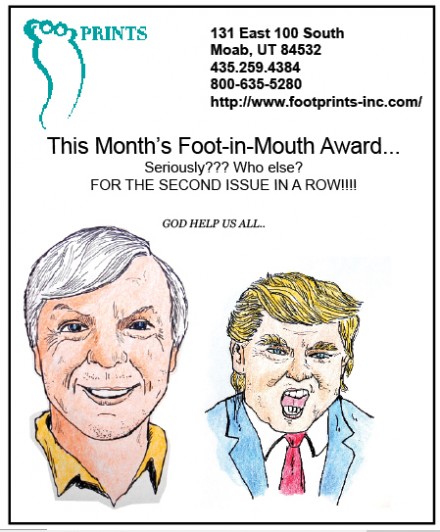I left the meeting, however, before it was over and headed out. I thought much about what had transpired and wondered if there would ever be a harmonious solution to the conflicts that exist.
We all know that it was Brigham Young’s policy that it was better to feed the Indians than to fight them. But if a fight was necessary, so be it. The early Mormons in Illinois and Missouri made a show to defend their property as they were being chased out. But I wonder how many of those early pioneers felt the Indians had the same right as they to defend themselves.
The response of the Indians in San Juan County, Utah, was much the same as elsewhere. They fought such encroachment and the taking of their lands and property. What they didn’t account for, as elsewhere, was the heavy hand of government troops. Indians were either compelled to submit or to be beaten into submission.
I’ll not recount all the battles and racial problems between the whites and the Indians in San Juan. That would take volumes. But here are a few…
Let’s start with Kit Carson at Fort Defiance in 1863. Backed by federal troops, he savagely rounded up the Navajo people to remove them to Fort Sumpter in New Mexico. The captives who surrendered voluntarily
were to be taken to the reservation to farm the land. The males who resisted would be shot and their livestock and food supplies destroyed. The military command marched the terrorized Navajos 300 miles, “The Long Walk,” to the Bosque Redondo concentration camp. By December 1864, the camp contained 8,354 Navajos. Hundreds eventually escaped but hundreds and hundreds died of disease and starvation. The tyrannical Kit Carson was later, in disgrace, relieved of his command.
The 14th Amendment to the Constitution proclaimed on July 28, 1868 that all persons born in the United States were naturalized citizens of the nation and state in which they resided. No state should now deprive any citizen of life, liberty or property without the due process of law. Obviously, this law was not made for all of our peoples.
Soon after this momentous document was passed, U.S. Military authorities forced the Navajo chiefs to sign a treaty on August 12, 1868, to agree to live on reservations and to cease their opposition to the whites. The forced treaty established a 3.5 million-acre reservation within the Navajo tribe’s old territory, a small portion of the original Navajo holdings. Even though it was later enlarged, the reservation originally held only 68,000 acres of farmland.
Sure the Navajos were not content. In the 1870s, Jacob Hamblin indicated a concern with the many Navajo raids on the Mormon frontier. He asked Brigham Young if he could be an ambassador to the Navajos in order to prevent further killings and to establish peace. A Paria Fort, with guards, was established near Lee’s Ferry crossing.
Ammon Tenney, a Mormon peacemaker, charged that in the previous year, the Navajos had stolen some $1,000,000 worth of cattle, horses and sheep in southern Utah. He was probably correct. The Navajos were indeed angry.
At a “great council” on Nov. 1, 1870, Tenney reports an estimated 8,000 hostile Indians on the council grounds at Fort Defiance. John Wesley Powell warned the Navajos that if they did not cease their raiding, federal troops would once again come upon them. Jacob Hamblin told the Navajos that many young Mormon men wanted to come across the river and kill Navajos, but that they preferred to make peace. He told them that Brigham Young was a man of peace. The raids continued.
Once fears diminished in the San Juan country, and the Navajos were safely corralled in their reservations, the whites now started to dribble in.
My great-grandfather, George Spencer, married three women in a polygamous-type relationship. And these three women had many children. Two of the children, Harriet Marinda Spencer and Lydia Spencer, (both from the third wife,) ventured into the San Juan country with their husbands in the early 1900’s to raise their families.
There were many begats from these great aunts of mine. I find kin among the Harrises, Bayles, Rogers, Washburns, Palmers, Stotts, Hunts, Hursts, Youngs, Blacks, Spencers, Hamiltons, Hancocks, Neilsons, Smiths, Somervilles, Nortons, Hawkins, Kartchners, Milliners, and other fine familes. I find relatives from those who came down through the Hole-in-the-Rock. One seems to have special status in San Juan County if one can count an ancestor as having come through “The Hole.” It’s a badge of honor, a special society, something akin to having an ancestor who came over on the Mayflower.
Even the exiled Mormons came back to Zion (San Juan) from Mexico to claim their “rightful heritage.”
But this society, as great as it was, brought with it a culture that was so different than that of the native people. Immediately, problems arose, and never to this day have the major racial problems been solved.
Brigham Young had decided to do something about the Navajo Indian problem. The Navajos were making raids “again the helpless settlers” of all southern Utah. So, in December 1878, a hundred or so Mormon men were recruited as scouts to map out a route to the San Juan country, the purpose of which was to eventually establish more settlements and to control the Navajos.
The company arrived at the San Juan River in July 1879 and for the next several weeks explored the whole river bottom from McElmo Wash to Butler Wash. They drew lots on the Navajo land. Every bit of farm land was claimed and some houses were built. The construction of a dam on the river was attempted, though unsuccessful. A wedding took place. Scouts were sent to explore the adjacent Navajo country—even as far north as Blue Mountain.
The exploring company then returned to their own homelands to ready the main body that would soon come. Some of the party returned on a route northward through Moab and Green River and thence westward over the Green River desert.
The main party started their journey in the Fall of 1879. They intended to make a short-cut through the canyon country to avoid the longer trek and hostile Navajos. Planning on a quick six-week trek, they formed a caravan of eighty wagons and some thousand head of cattle. On reaching the Colorado River, they hacked out a notch at “the Hole” and let their wagons down Uncle Ben’s dugway. Then they built a dugway up the other side. Now that they had experience, they built many more dugways. The trip took them six months to reach Bluff, not six weeks. At Bluff, they established a foothold.
Next, the Dawes Act, (the Indian General Allotment Act of 1887,) allotted land to individual tribe members with the aim to break up the communal land base of the Indian tribes. Upon the break up of reservation lands, the lands not allotted would then be open for white settlement. As Utah was not then a state, the law would not effect Utah Indians until 1896.
Under the 1891 Indian Mineral Leasing Act, no executive-order lands could be opened to oil and gas exploration and development. However, this did not stop illegal exploration.
President Benjamin Harrison signed an executive order withdrawing the western half of the Utah Strip from the Navajo reservation, restoring it to the public domain. The “mining interests” in the Utah Strip were indeed strong. Plans for mineral exploitation had already been made.
Utah continued its racist policies. An 1897 Utah law withheld residency from anyone who lived on an Indian reservation unless that person had previously established residency in an off-reservation Utah county.
In 1923, agencies of the BIA issued Indian allotments on the public domain north of the San Juan River in San Juan County. New lands were promised.
Many special interest groups continued to press for restoring parcels of reservation land to the public domain. They would do this through the executive-order process.
In 1927, however, Congress enacted the Indian Oil Act, which prohibited the Secretary of Interior from withdrawing such lands.
In 1930, the BIA halted its off-reservation allotment program, even though many unallotted Utah Navajos 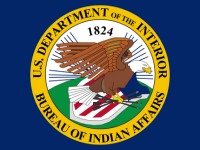 were living on public domain lands north of the reservation boundaries. These lands became eligible for disposal under Taylor Grazing Act provisions in 1934. Many of the Navajos who were removed had never surrendered to Kit Carson and the federal troops. Though they never signed the land cession treaty of 1868, they were still relocated off their ancestral lands by the BLM.
were living on public domain lands north of the reservation boundaries. These lands became eligible for disposal under Taylor Grazing Act provisions in 1934. Many of the Navajos who were removed had never surrendered to Kit Carson and the federal troops. Though they never signed the land cession treaty of 1868, they were still relocated off their ancestral lands by the BLM.
In 1933, the U.S. Congress created the Utah Navajo Trust Fund when the Aneth Extension was added to the Navajo Reservation from public lands. Residents of this area were designated beneficiaries, with the state as trustee, should oil be discovered. The amount of 37 ½ percent of royalties on the discovered oil was to be deposited with the State of Utah to be used for the benefit of the Navajo people.
In 1946, Congress established the Indian Claims Commission. It was drafted by Mormon lawyer Ernest Wilkinson. Under this law, affected Indian tribes could file monetary claims against the U.S. Government for the taking of their aboriginal lands. However, the payment of the claim had the legal effect of extinguishing tribal aboriginal land title. It was a Navajo Catch-22.
Not surprisingly, Mormon Senator Arthur Watkins was appointed to head the Claims Commission. And Wilkinson’s law partner, John Boyden, became the Hopi Tribal Council’s attorney. Boyden busied himself in negotiating confiscated lands with the awards pain to the Hopi tribal council. He also prepared lease contracts that were to be negotiated with mining companies. Later, Boyden would be instrumental in gaining secured lease arrangements with Peabody Coal to strip mine 58,000 acres of Hopi land. Also, leases were secured to build power plants on Navajo lands. Displaced by these projects were the traditional leaders and Navajo sheep herder.
In 1951, the Navajo tribe filed a lawsuit with the Indian Claims Commission seeking monetary compensation for the loss of 24 million acres of aboriginal land outside the reservation. The Tribe claimed compensatory interest in land as far north as the Abajo Mountains. This included Cedar Mesa.
As if in retaliation, in 1952, Utah Senator Arthur Watkins led a “termination” movement in Congress. Reservations were to be broken up, tribal governments abolished, and federal treaty obligations ended. His efforts led to the extinction of a number of Indian entities and their land rights.
In 1956, Utah shamefully became the last state to allow Indians on reservations to vote. The Utah attorney general issued an opinion that reservation Indians could not vote. A state law said that anyone living on a reservation was not a resident of the state. This opinion was upheld by the Utah Supreme Court, which ruled Indians should be barred from voting because they were “not as conversant with no as interested in government as other citizens.”
The Utah legislature wisely amended the law, rendering the Utah Supreme Court’s decision null and void, but not before Utah was branded as racist by the national press.
In 1978, Jack Jones, a descendant of Kaiyella Band, filed a land claim with the Department of Interior for the taking of lands north of the San Juan River held by his ancestors. He claimed the area located outside of the reservation boundaries and the McCracken Mesa addition but within the public domain in San Juan County.
To back up his claim, members of the Kaiyellas bravely demonstrated and occupied the oil fields.
In 1979, the Field Solicitor determined that Mr. Jones’ claim had been blocked by the McCracked Mesa land transfer legislation and by the 1958 act exchanging lands taken for the construction of Glen Canyon Dam, which created Lake Powell.
And so we come to Judge Sam’s recent decision clothed in a lot of mumbo-jumbo. He goes so far as to say there is no trust fund and that the Navajo beneficiaries have no right to bring suit. What floors me is that the Utah Attorney General’s office refuses to help guarantee those sacred citizen rights to speak out. So what is new? It’s back to square one. I think we need more advocates nipping at a lot of heels.
Despite the 1995 ruling, the Navajo Reservation continued its fight against the mismanagement of its trust fund. Litigation carried on for nearly twenty years, until, in 2010, the State of Utah agreed to pay $33 million to the Plaintiffs to settle their liability. Meanwhile, in 2008, the State withdrew from managing the fund, and handed over responsibility to the Utah Navajo Royalties Fund, a temporary agency charged with overseeing the trust fund until the U.S. Congress designates a new, official trustee.
Ken Sleight still lives at Pack Creek Ranch near Moab.
Click Here to Read the Previous Installments of Ken Sleight Remembers…
To read the PDF version of this article, click here.
To comment, scroll to the bottom of the page.
Don’t forget the Zephyr ads! All links are hot!


